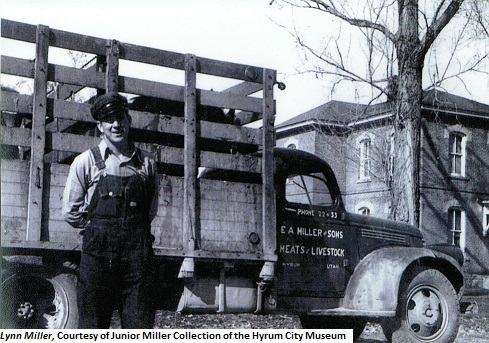Dublin Core
Title
Description
Learn about E.A. Miller & Sons, a small family business started during the Great Depression, and how it grew to be part of the world’s largest beef producer.
In 1935, in the small town of Hyrum, in Utah’s rural Cache Valley, Ernest and Florence Miller started a business. They bought a piece of land and built a slaughterhouse where they began to butcher meat. Through hard work and innovation, their E.A. Miller & Sons Company grew from a modest family business into one of the nation’s leading beef producers.
The Miller operation was small at first. Ernest bought cattle from local farmers and Florence wrapped and delivered meat. Like other agricultural processing industries in Cache Valley, their product was locally grown. But while other companies shut down over time because local farms couldn’t supply enough product, Millers acquired its own feed yards, livestock, and farms, so was not dependent on local supply.
Further expansion ensured Millers was not dependent on local consumers either. The company established a trucking fleet to deliver products to market. Then in the 1950s, Utah certified Millers as a state meat inspector, which allowed the company access to national markets. Plus, the company diversified its business by opening a rendering plant to process inedible byproducts of the butchering operation. They also took advantage of shifting supermarket trends by delivering their famous “Blue Ribbon Beef” pre-packaged to grocers, ready for consumers. By controlling various components of the meat-processing business, Millers enjoyed more autonomy and weathered market fluctuations more readily than its competitors.
With these innovations, Millers grew exponentially, which meant more laborers. By the 1960s, Millers employed 160 workers in Hyrum – nearly 10% of the population. Most people in town had family members, friends, or neighbors who worked for the company. And as Millers continued to grow, it attracted an immigrant workforce that diversified the community.
From its roots as a small family business, E.A. Miller & Sons innovated its way to becoming part of JBS Beef, a global company that is the world’s largest beef producer. Today, its Hyrum plant employs more than 1200 workers, who speak a dozen languages, and remains a big company in a small town.
Creator
Jami J. Van Huss for the Hyrum City Museum © 2017
Source
Image: Lynn Miller, son of Earnest and Florence, worked with his parents and brother, Junior, to turn their family business into one that proved crucial to the health of Hyrum’s local economy. Image courtesy Junior Miller collection of the Hyrum City Museum.
_______________
See Earle Allen, Bessie Brown, and Lila Eliason, Home in the Hills of Bridgerland, Hyrum City, UT, 1969, pp. 309-322; “E.A. Miller and Sons Open New Processing Plant in Hyrum,” South Cache Courier, November 24, 1939; A History of E.A. Miller & Sons Packing Co., June 14, 1968, Hyrum City Museum Archive; and Hyrum City Museum, exhibition file for “Tradition & Innovation: Working Together in Hyrum,” curated by Jami J. Van Huss, 2017.

